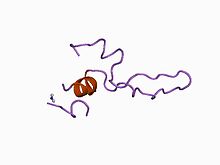

| Cholecystokinin A receptor, N-terminal domain | |||||||||
|---|---|---|---|---|---|---|---|---|---|

molecular complex of cholecystokinin-8 and n-terminus of the cholecystokinin a receptor by nmr spectroscopy
| |||||||||
| Identifiers | |||||||||
| Symbol | CholecysA-Rec_N | ||||||||
| Pfam | PF09193 | ||||||||
| InterPro | IPR015276 | ||||||||
| SCOP2 | 1d6g / SCOPe / SUPFAM | ||||||||
| |||||||||
The Cholecystokinin A receptor is a human protein, also known as CCKARorCCK1, with CCK1 now being the IUPHAR-recommended name.
This gene encodes a G-protein coupled receptor that binds sulfated members of the cholecystokinin (CCK) family of peptide hormones. This receptor is a major physiologic mediator of pancreatic enzyme secretion and smooth muscle contraction of the gallbladder and stomach. In the central and peripheral nervous system this receptor regulates satiety and the release of beta-endorphin and dopamine.[5]
The extracellular, N-terminal, domain of this protein adopts a tertiary structure consisting of a few helical turns and a disulfide-cross linked loop. It is required for interaction of the cholecystokinin A receptor with its corresponding hormonal ligand.[6]
This article incorporates text from the United States National Library of Medicine, which is in the public domain.
|
PDB gallery
| |
|---|---|
|
1d6g: MOLECULAR COMPLEX OF CHOLECYSTOKININ-8 AND N-TERMINUS OF THE CHOLECYSTOKININ A RECEPTOR BY NMR SPECTROSCOPY
|
|
| |||||||||||||||||||||||||||||||||||
|---|---|---|---|---|---|---|---|---|---|---|---|---|---|---|---|---|---|---|---|---|---|---|---|---|---|---|---|---|---|---|---|---|---|---|---|
| |||||||||||||||||||||||||||||||||||
| |||||||||||||||||||||||||||||||||||
| |||||||||||||||||||||||||||||||||||
| |||||||||||||||||||||||||||||||||||
|
| |||||||||||||
|---|---|---|---|---|---|---|---|---|---|---|---|---|---|
| G protein-coupled receptor |
| ||||||||||||
| Type I cytokine receptor |
| ||||||||||||
| Enzyme-linked receptor |
| ||||||||||||
| Other |
| ||||||||||||